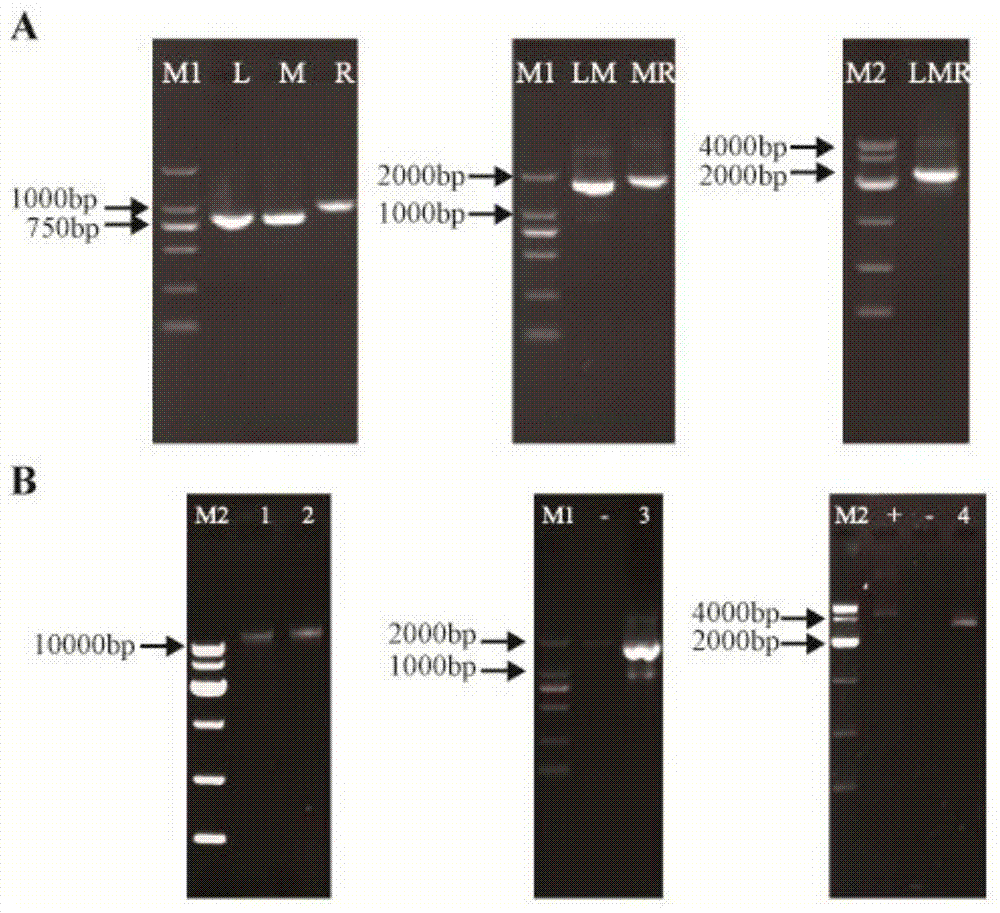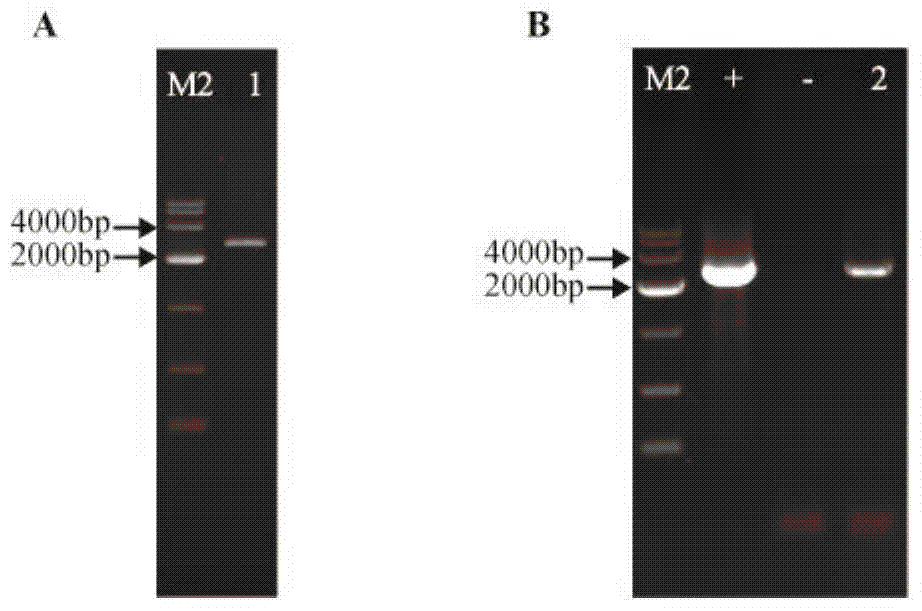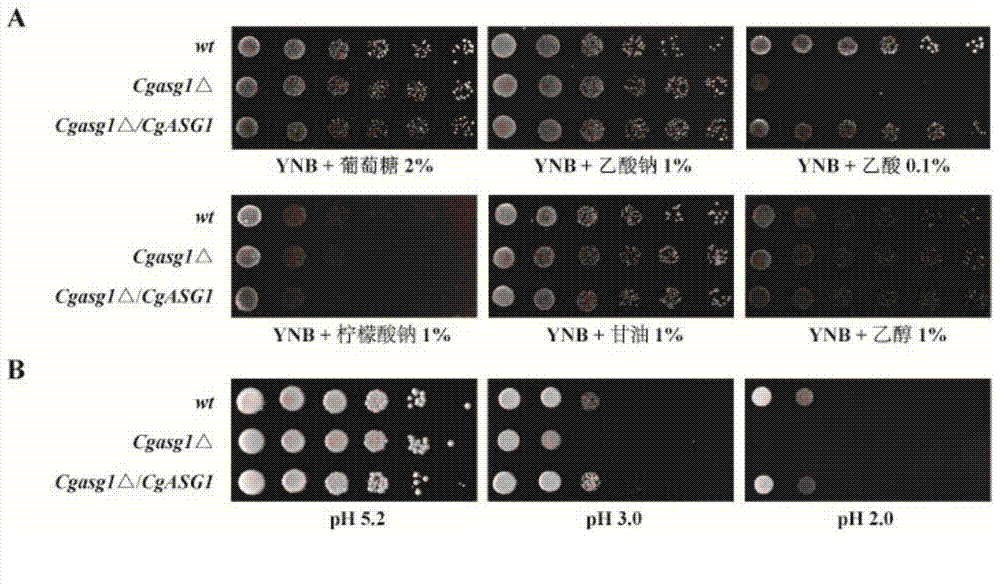Transcription factor Asg1p for regulating and controlling acid stress resistance of Candida glabrata
A technology of Torulopsis glabrata and transcription factors, which can be applied in fermentation, genetic engineering, plant genetic improvement, etc., and can solve problems that have not been widely developed
- Summary
- Abstract
- Description
- Claims
- Application Information
AI Technical Summary
Problems solved by technology
Method used
Image
Examples
Embodiment 1
[0028] The C.glabrataATCC 2001 (wt) genome was used as a template, and P1 / P2, P3 / P4, and P5 / P6 were used as primers to amplify the left arm (L), uracil Gene (M) and right arm (R), the knockout box CgASG1-LMR was constructed by fusion PCR ( figure 1 A). The starting strain C.glabrataATCC 55 could not be used in MM screening medium (glucose 20g·L) due to the deletion of uracil gene -1 , urea 7g·L -1 , sodium acetate 3g·L -1 , sodium dihydrogen phosphate 5g·L -1 , magnesium sulfate heptahydrate 0.8g·L -1 , agar powder 20g·L -1 ), and the mutant strains grew on MM medium due to the expression of the marker gene uracil after homologous recombination. Perform PCR verification on transformants, such as figure 1 As shown in B, the genome of the transformant was extracted, and it was found that when P7 / P8 was used as the primer, the wild-type strain wt had no bands, but the transformant obtained the left arm of the gene CgURA3 and gene CgASG1 of about 1.8kb. The correct mutant ...
Embodiment 2
[0038] With the C.glabrataATCC 2001 (wt) genome as a template, the amplified gene fragment CgASG1( figure 2 A, 2.5kb) was ligated to plasmid pY13TEF after double enzyme digestion to construct plasmid pY13-CgASG1. The mutant strain Cgasg1Δ cannot grow on the MM selection medium due to the deletion of histidine gene, and the histidine gene on the plasmid pY13TEF can make the complementing strain obtain this growth ability. Colony PCR screening verification found that the mutant strain Cgasg1Δ as a control had no band production, while the transformant was amplified to obtain a specific fragment ( figure 2 B, 2.5kb), this strain was named Cgasg1Δ / CgASG1.
[0039] P9: CGGGATCCATGAACTTGACTGTGCCAC
[0040] P10: CGGAATTCTTAGGCGTTATTAGTAGGTAAAT
Embodiment 3
[0042] Plate growth experiments were performed to analyze the effects of different carbon sources on the growth of strains wt, Cgasg1Δ and Cgasg1Δ / CgASG1, such as image 3 A, The mutant strain Cgasg1Δ showed the same growth condition as the wild-type strain wt on the YNB medium with sodium acetate, sodium citrate, glycerol or ethanol as the sole carbon source, but it grew weakly on the acetic acid medium. Comparing the growth of acetic acid and sodium acetate as the only carbon source, it was found that the reason for the weak growth when acetic acid was used as the carbon source was the pH drop caused by acetic acid. Further changing the pH of the YNB medium, the growth of the strain is as follows image 3 B, It was found that the growth of the mutant strain Cgasg1Δ was inhibited at pH 3.0 and could not grow at pH 2.0; while the complementing strain Cgasg1Δ / CgASG1 showed the same growth phenotype as the wild-type strain wt on any medium. The cell viability of the strain wt a...
PUM
 Login to View More
Login to View More Abstract
Description
Claims
Application Information
 Login to View More
Login to View More - R&D
- Intellectual Property
- Life Sciences
- Materials
- Tech Scout
- Unparalleled Data Quality
- Higher Quality Content
- 60% Fewer Hallucinations
Browse by: Latest US Patents, China's latest patents, Technical Efficacy Thesaurus, Application Domain, Technology Topic, Popular Technical Reports.
© 2025 PatSnap. All rights reserved.Legal|Privacy policy|Modern Slavery Act Transparency Statement|Sitemap|About US| Contact US: help@patsnap.com



